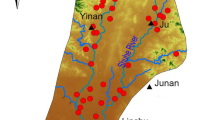Abstract
A study involving geophysical survey and groundwater analysis was carried out at the Igbenre Ekotedo dumpsite in Ota, Southwest Nigeria. The aim was to monitor and track the depth of leachate contamination around the dumpsite. A proposed simple multiple linear regression (MLR) model of groundwater total dissolved solids (TDS) was also developed. This was achieved by correlating the observed TDS of groundwater samples collected within and around the vicinity of the dumpsites with multiple terrain conductivity data derived from a geophysical method. The results of the electrical resistivity tomography (ERT) obtained along four profile lines in August 2014, and a time-lapse survey in December 2015 delineated leachate plumes as low-resistivity zones ranging between 0.54 and 12.5 Ω m around the dumpsite, with good correlation between the wet and dry season models. The results also showed that leachate from the decomposed refuse materials has polluted the subsurface under the dumpsite from the surface to a depth of about 45 m, and by extension contaminating groundwater aquifer around the area. Results from the electromagnetic (EM-34) experiment and groundwater TDS parameters from seven (7) boreholes around the vicinity of the EM profiles showed a strong positive correlation. Therefore, a simple multiple linear regression (MLR) TDS model that relates the TDS data obtained from boreholes to the geophysical parameters obtained from the EM-34 data (HD 20, HD 40, and VD 40) was developed for the purpose of efficient groundwater resources monitoring and management around the dumpsite and their communities. The predictive power of the developed MLR TDS model was also apprised to determine the feasibility of using the TDS model to predict and estimate groundwater TDS around the study area. The developed TDS model can be reliably deployed for groundwater TDS estimation and monitoring around the study area where there are no boreholes, but with only terrain conductivity data. However, where there are borehole and hand-dug wells, terrain conductivity data around the area alone can be applied to the model to determine TDS concentration in groundwater, thus reducing the time and cost of determining and monitoring both parameters independently.









Similar content being viewed by others
References
Agagu OK, (1985). A geological guide to bituminous sediments in southwestern Nigeria. Unpubl. Report, Department of Geology, University of Ibadan
AGI (2003) Earth imager 2D resistivity inversion software, version1.5.10. Advanced geosciences, Inc, Austin
Ameloko AA, Ayolabi EA, Akinmosin A (2018) Time dependent electrical resistivity tomography and seasonal variation assessment of groundwater around the Olushosun dumpsite Lagos, South-west, Nigeria. J Afr Earth Sci 147:243–253
Ayolabi EA, Lucas OB, Chidinma ID (2014) Integrated geophysical and physicochemical assessment of Olushosun sanitary landfill site, Southwest Nigeria. Arab J Geosci 8:4101–4115. https://doi.org/10.1007/s12517-014-1486-8
Enu EI (1990) Nature and occurrence of tar sands in Nigeria. In: Ako BD, Enu EI (eds) Occurrence, utilization and economics of tar sands. Nigeria Mining and Geosciences Society publication on tar sands workshop. Olabisi Onabanjo University, Ago–Iwoye, pp 11–16
Frischknecht FC, Labson VF, Spies BR, Anderson WL (1991) Profiling methods using small sources. In: Nabighian MN, Corbett JD (eds) Electromagnetic methods in applied geophysics- application part A. Society of Exploration Geophysicists, Tulsa, pp 105–270
Grady SJ, Haeni FP (1984) Application of electromagnetic techniques in determining distribution and extent of ground water contamination at a sanitary landfill, Farmington, Connecticut. In: Nielsen DM, Curl M (eds) NWWA/EPA Conference on surface and borehole geophysical methods in ground water investigations. Nation Water Well Association (publisher), San Antonio, pp 338–367
Idornigie AI, Olorunfemi MO, Omitogun AA (2006) Electrical resistivity determination of surface layers, soil competence and soil corrosivity at an engineering site location in Akungba-Akoko, southwestern Nigeria. IFE J Sci 8(2):159–177
Jones HA, Hockey RD (1964) The geology of part of southwestern Nigeria. Geol Surv Nigeria Bull 31:87
Koutsoyiannis A (1977) Theory of econometrics: an introductory exposition of econometrics methods, 2nd edn. Palgrave, New York
Loke MH, Barker RD (1996) Rapid least-squares inversion of apparent resistivity pseudosection by quasi-Newton method. Geophys Prospect 44:131–152
McNeill, J. D., (1980). Electromagnetic terrain conductivity measurement at low induction numbers: Geonics, Ltd. Technical note 6, Geonics Ltd, Mississauga, Ontario, 15 p
Neil, M. and Fenton N. E., (1996). Predicting software quality using Bayesian belief networks, Proc 21st Annual Software Eng Workshop, NASA Goddard Space Flight Centre, pp217–230
Nton, ME, (2001). Sedimentological and geochemical studies of rock units in the eastern Dahomey basin, southwestern Nigeria. Unpublished Ph.D. thesis, University of Ibadan, pp 315
Olorunfemi MO, (2001). Geophysics as a tool in environmental impact assessment, NACETEM, Obafemi Awolowo University, Ile Ife, Course on Environmental Impact Assessment
Omatsola ME, Adegoke OS (1981) Tectonic evolution and cretaceous stratigraphy of the Dahomey basin. J Min Geol 18(1):130–137
Powers CJ, Wilson J, Haeni FP, Johnson CD (1999) Surface-geophysical investigation of the University of Connecticut Landfill. U.S. Geological Survey Water-Resources Investigations Report, Storrs, Connecticut, pp 99–4211 34 p
Acknowledgments
The authors acknowledge Ogun State Waste Management Authority for permission to work on their dumpsite.
Funding
The authors acknowledge the funding support offered by Covenant University for the project.
Author information
Authors and Affiliations
Corresponding author
Additional information
Responsible Editor: Broder J. Merkel
Rights and permissions
About this article
Cite this article
Aduojo, A.A., Adebowole, A.E. Geophysical and hydrophysical evaluation of groundwater around the Igbenre Ekotedo dumpsite Ota, Southwest Nigeria, using correlation and regression analysis. Arab J Geosci 13, 896 (2020). https://doi.org/10.1007/s12517-020-05875-w
Received:
Accepted:
Published:
DOI: https://doi.org/10.1007/s12517-020-05875-w




